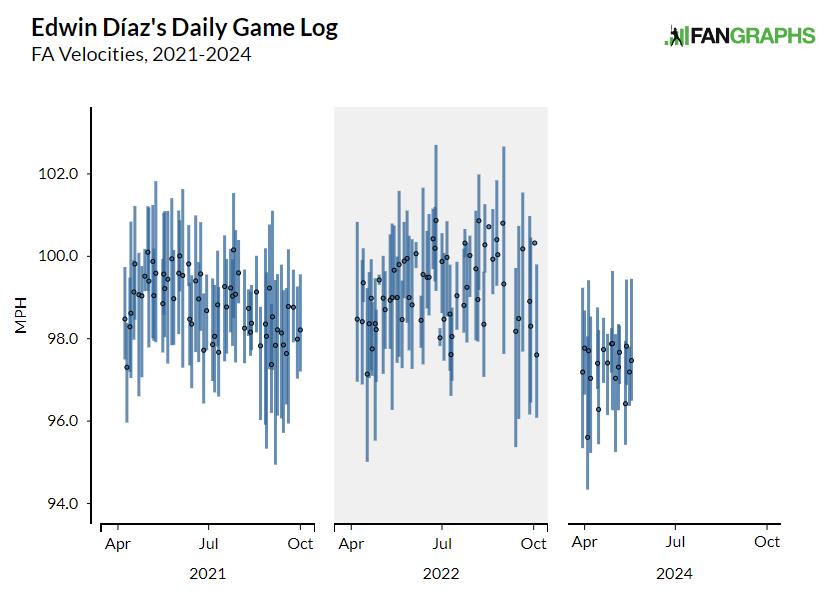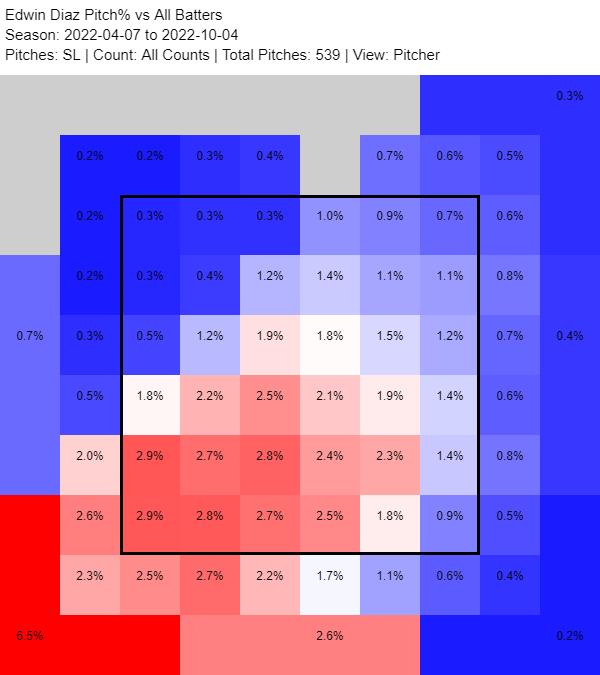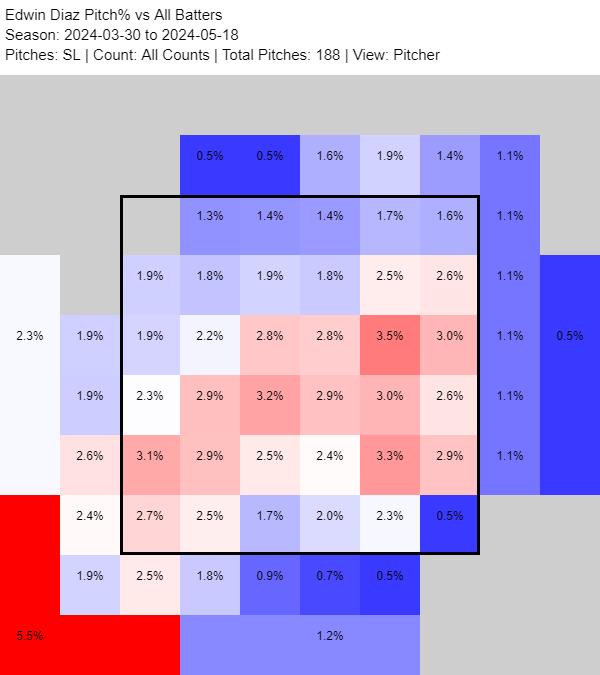
Vincent Carchietta-USA TODAY Sports
What’s wrong with Edwin Díaz? In a single GIF, this is what’s wrong with Edwin Díaz:
I don’t want to tell him how to pitch, because he’s Edwin Díaz and I’m an anonymous person on the internet. But putting a slider right in Josh Bell’s nitro zone is not a great way to approach a high-leverage at-bat. Bell put a good swing on it, which was hardly a given, but Díaz put himself into that situation and paid the price for it.
On a superficial level, there’s not a lot of uncertainty over what’s wrong. During the 2023 World Baseball Classic, Díaz tore his patellar tendon, and then he missed the entirety of the season recovering from surgery that repaired that tendon. He’s back on the mound, but he’s clearly not the same pitcher that he was in his dominant 2022 season.
First, there’s his fastball. It averaged 99 miles an hour in 2022. This season, it’s sitting in the 97-98 range, and he still hasn’t surpassed 100 mph on a single pitch. He’d go weeks in 2022 averaging triple digits. It’s a noticeable change in profile:

Now, Díaz’s fastball is still excellent despite the lower velocity. He’s always had a devastating movement profile; his arm slot and long stride produce a shallow approach angle that mystifies hitters at the top of the zone. Hitters are doing more damage than normal when they make contact, but they’re still swinging and missing plenty. Let’s put it this way: For his career, Díaz has allowed a 71% contact rate against his fastball. This year, it’s at 66.7%. From that perspective, things aren’t so terrible.
The problem comes with his slider. That cement mixer to Bell isn’t an isolated incident. Díaz’s transformation from excellent closer to otherworldly force wasn’t built on fastballs. It was built on his turning that slider into a surgical tool. Look at this gorgeous map of his 2022 slider locations:

That’s nearly flawless. He wore out the lower gloveside corner with 90 mph darts. This year, to put it mildly, he hasn’t been doing that:

Commanding that slider low and away made Díaz completely untouchable. He threw 539 sliders in 2022. Opponents hit exactly one of them for extra bases. In 2021, another solid year, he threw 378 sliders and gave up only three doubles with it. All of those hits were on location mistakes in hitter’s counts. This year, he’s already surrendered five extra base hits, including three homers, off his slider. Only one of the 1,099 sliders he threw from 2020 through 2022 was hit for a home run.
The easiest way to describe what’s gone wrong is those two heatmaps, but if you’re not a visual learner, we can do it in numbers too. In 2022, 23.6% of his sliders ended up over the heart of the plate. That number is up to 32.4% this year. On the other hand, he’s still missing the zone badly just as frequently. He’s essentially lost his fine control of the edges of the zone, the location where pitchers almost always win. He hit the shadow zone — the edges of the plate and the area just off of it — 43.1% of the time in 2021 and 38.6% of the time in 2022 with sliders. This year, that number is down to 32.4%.
The news only gets worse from there. Díaz’s slider, like his fastball, is down a few ticks of velocity. Unfortunately, its movement profile didn’t survive the decline in velocity nearly as well as the heater’s did. His slider is now inducing roughly three inches of positive vertical break, or lift. It’s gone from falling half an inch less than similar-looking sliders to falling two inches less than them. For a gyro slider like his, getting the ball to fall more is key. You want the path to diverge as much as possible from normal fastball shape. Instead, his slider is hanging up in the zone. I think that this is both messing with his command and making it easier for hitters to get the head of the bat to the ball.
Don’t just take that movement argument from me, though. PitchingBot thinks that the slider has gone from a 77 on the 20-80 scale to a 63. Stuff+ thinks it’s gone from 165 (normalized around 100) to 119. Both models agree that his command has gotten worse, to boot. You can take a tour of the internet to check out other people’s stuff models, and they’ll all agree. Díaz just isn’t shaping the pitch like he used to. The combination of slower speed and more induced vertical lift just makes it less devastating, no two ways about it.
Unfortunately, the straightforward nature of Díaz’s decline doesn’t make it any easier to fix. His pitches just aren’t working like he needs them to. To make matters worse, he seems less certain of his command – reasonably so, given the change in pitch shape. Not only is he walking 9.1% of opposing batters, his highest mark (excluding a 25-inning 2020 season) since 2017, but he’s doing so despite a plan to avoid walks at any cost.
When Díaz gets behind in the count, he just throws the ball down the middle and hopes for the best. He’s throwing 37.8% of his pitches over the heart of the plate in such situations, the highest mark of his career and among the 15% most aggressive of pitchers across the league. That’s the domain of pitch-to-contact and sinker-dominant types, not swing-and-miss closers. He hangs his slider middle-middle a shocking 41.3% of the time when he’s down in the count. He’s never even approached that mark before.
The solution to this sudden malaise is simple and yet difficult: Díaz needs to get healthy again. Failing that, he needs to adjust to pitching with lower velocity and refine his slider grip to get rid of that pesky extra vertical lift he’s added this year. With the pitch’s current shape, velocity, and location, he simply can’t get away with throwing it as a primary option. Maybe that means developing a slower, sweepier version. Maybe it means going back to working off of his fastball, saving sliders for ambushes. It’s a lot harder to hit an average slider if you’re trying to catch up to 98 up in the zone.
Regardless of what his plan is, Díaz needs to do something, and he knows it. He’s told reporters that he lacks confidence at the moment, and I think that’s a great way of explaining what’s going on. He just isn’t commanding and finishing the slider like he’s used to, and it’s getting in his head. That just spirals, because he needs the slider in bigger spots, and so on and so forth.
The history of patellar tendon injuries in baseball suggests that Díaz will be fine with time. Former Angels hurler Garrett Richards suffered a tear in his landing leg and was back in action within eight months. Zach Eflin tore his in July 2021 and contributed to the bullpen throughout 2022. Matt Strahm has had surgery on both patellar tendons and is pitching better than ever. There’s no clear path back to feeling fully healthy, but the long-term prognosis looks good.
That’s great news, but it doesn’t do a lot to help out in the present. The Mets are mired below .500 despite some solid individual performances; their BaseRuns record is 23-23, and they’re still very much in the playoff hunt. Their bullpen has been among the best in baseball despite Díaz’s struggles; Reed Garrett has been sublime and the middle innings crew has also been excellent. Carlos Mendoza indicated that Díaz will take on some lower-leverage work while he rounds back into form. That seems like a good plan to me. This isn’t a case of a manager reacting to small-sample-size struggles. Díaz is just worse right now. The trumpets will surely play in Citi Field again, but their conductor needs to get right first.
Source
https://blogs.fangraphs.com/edwin-diaz-isnt-fully-back-yet/
 Backyard GrillingWeekend WarriorsAdvice from DadBeard GroomingTV Shows for Guys4x4 Off-Road CarsMens FashionSports NewsAncient Archeology World NewsPrivacy PolicyTerms And Conditions
Backyard GrillingWeekend WarriorsAdvice from DadBeard GroomingTV Shows for Guys4x4 Off-Road CarsMens FashionSports NewsAncient Archeology World NewsPrivacy PolicyTerms And Conditions
